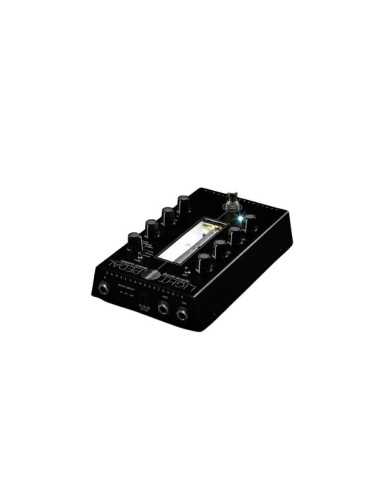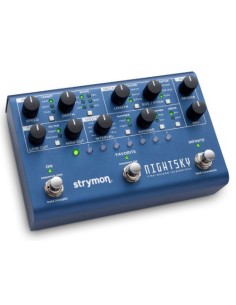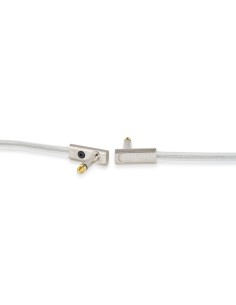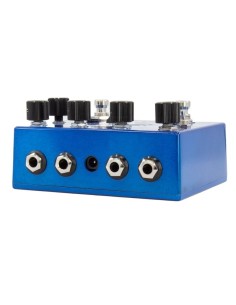LIGHT pedaal on maailma esimene analoog optiline spring reverb süsteem mis kasutab infrapuna optiliseid sensoreid, et püüda kogu harmooniline ja tämbriline spring reverb heliväli. Tulemuseks on palju erinevaid analoog reverb kõlasid ulatudes klassikalistest, eksperimentaalsetest kuni puhta võluväeni välja!
THE CLASSIC SPRING TANK SOUND
The LIGHT Pedal’s central component and main sound source is a traditional spring reverb tank, consisting of three major elements - the input transducer (spring exciter), the springs and the output transducer (pickup). There can be a lot of complexity in the spring’s movement patterns during the reverberation process, especially near the input transducer. However, due to the spring elasticity, by the time vibrations have reached the output transducer we mostly hear the spring’s own resonant frequencies, which is why all spring reverbs have such a particular jangly, metallic sound. The LIGHT Pedal’s spring output (the spring knob) offers a classic high-quality spring reverb sound with the option to adjust the spring “drip” (the drive knob) and the tone of the output signal (the tone knob).
THE OPTICAL SPRING REVERB SOUND
To capture the full range of the spring’s vibrations, the LIGHT Pedal uses multiple sets of special infra-red optical sensors that act as photoelectric pickups. Each set of IR sensors is directed at a different point on the moving spring’s surface. The optical sensors detect much finer movements compared to the output transducer. This makes longer decays possible and more detailed frequency response, including subharmonics and overtones. Additionally, the pedal can achieve amazing modulation and tremolo effects by scrolling through the optical sensors or by switching them on and off (optical effects).
FEATURES / BULLET POINTS
- Sounds ranging from classic spring tank tones to colorful optical spring reverb tones with modulation and added harmonics.
- Separate level controls for the dry signal, spring and optical reverbs. The dry signal can be attenuated and boosted.
- 6 unique effects: optics (frequency and texture calibration), sweep (modulation), tremolo, reflect (delay), feedback and harmonic (added harmonics and octave tracking). Multiple effect stacking options.
- Drive knob for adjusting the signal level sent to the reverb tank, thus affecting the reverb tank’s behavior.
- Tone knob ranges from rumbling lows to piercing highs.
- Simple one-knob envelope control produces either gated or ducking reverb.
- Effects parameters can be linked to playing dynamics.
- Switchable reverb tails in bypass mode.
- Switchable latching or momentary modes for expressive playing.
- Assignable expression pedal input.
- Adjustable shock sensor to control spring noise produced by sudden movements, mechanical impact.
- Color LEDs inside the spring tank provide helpful visual feedback for monitoring the reverb’s output and input signal levels as well as multiple effects parameters, such as modulation rate.
- High quality buffered bypass.
- Powered by a standard 9V DC center negative power supply with at least 500 mA. Power supply is not included.
THE EFFECTS
- optics – lets you choose a specific combination of optical sensors, each with a slightly different texture and timbral quality.
- sweep – sweep is a modulation mode that rhythmically scrolls back and forth through the different optical sensor pairs. The different frequency response properties of each sensor result in a modulation-style effect.
- trem – a tremolo effect is produced by rhythmically switching the optical sensors on and off. The tremolo effect can also be applied to the spring output together with the optical signal or separately.
- reflect - this mode is a lo-fi delay that will send the instrument’s signal back into the reverb tank several times. Long delay times can create powerful, lengthy reverb decays.
- feedback – the feedback mode sets the spring tank into self-oscillation, which lets you produces various drones and wall-of-sound-type pads. Lots of potential uses when paired with an expression pedal or when in momentary mode.
- harmonic – in harmonic mode the spring tank is driven by a special circuit designed to produce added overtones and harmonics. Think of it as a shimmer reverb effect, but only produced naturally within the spring tank.
THE CONTROLS
- 3 mix controls: dry, spring (classic spring sound) and optical (optical spring reverb sound);
- tone – shared between the spring and optical sounds, and does not apply to the instruments dry signal;
- 6-way effect selector knob
- ctrl – effect parameter control knob
- drive – spring tank’s input signal level;
- gate – primary function: gated and ducking reverb control; secondary function – ctrl knob envelope response control.
- tails – turns reverb tails on or off
- latch – sets the pedal into latching mode (on) or into momentary mode (off).
- shock sensor - shuts off the wet signal output when mechanical impact or a shaking motion is detected; three levels of shock protection: off, soft and hard.
- soft footswitch – the primary function: toggling bypass; secondary functions – effects stacking, adjusting the envelope control over the effects, and entering the footswitch assignment mode.
GCALP
Uus
Teile võib meeldida ka

























